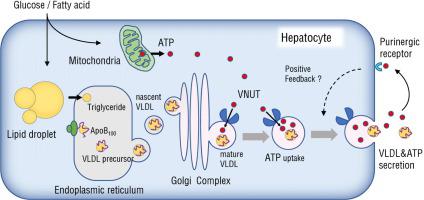Biochimica et Biophysica Acta (BBA) - Molecular Basis of Disease ( IF 6.2 ) Pub Date : 2020-11-17 , DOI: 10.1016/j.bbadis.2020.166013 Keita Tatsushima 1 , Nao Hasuzawa 2 , Lixiang Wang 3 , Miki Hiasa 4 , Shohei Sakamoto 5 , Kenji Ashida 2 , Nobuyuki Sudo 6 , Yoshinori Moriyama 7 , Masatoshi Nomura 2

|
Non-alcoholic steatohepatitis (NASH) is becoming a growing public health problem along with the increase of metabolic syndrome worldwide. Extracellular nucleotides are known to serve as a danger signal by initiating purinergic signaling in many inflammatory disorders, although the role of purinergic signaling in the progression of NASH remains to be clarified. Vesicular nucleotide transporter (VNUT) is a key molecule responsible for vesicular ATP release to initiate purinergic signaling. Here, we studied the role of VNUT in the progression of nonalcoholic steatohepatitis. VNUT was expressed in mouse hepatocytes and associated, at least in part, with apolipoprotein B (apoB)-containing vesicles. High glucose stimulation evoked release of appreciable amount of ATP from hepatocytes, which disappeared in hepatocytes of Vnut knockout (Vnut−/−) mice. Glucose treatment also stimulated triglyceride secretion from hepatocytes, which was inhibited by PPADS and MRS211, antagonists of P2Y receptors, and clodronate, a VNUT inhibitor, and was significantly reduced in Vnut−/− mice. In vivo, postprandial secretion of triglyceride from hepatocytes was observed, while the serum triglyceride level was significantly reduced in Vnut−/− mice. On a high-fat diet, the liver of wild type mice exhibited severe inflammation, fibrosis, and macrophage infiltration, which is similar to NASH in humans, while this NASH pathology was not observed in Vnut−/− mice. These results suggest that VNUT-mediated vesicular ATP release regulates triglyceride secretion and involves in chronic inflammation in hepatocytes. Since blockade of vesicular ATP release protects against progression of steatohepatitis, VNUT may be a pharmacological target for NASH.
中文翻译:

肝细胞水泡中ATP的释放在非酒精性脂肪性肝炎的进展中起作用
随着世界范围内新陈代谢综合征的增多,非酒精性脂肪性肝炎(NASH)成为日益严重的公共卫生问题。尽管嘌呤能信号在NASH进程中的作用尚待弄清,但已知胞外核苷酸可通过引发嘌呤能信号在许多炎症性疾病中充当危险信号。水泡核苷酸转运蛋白(VNUT)是负责水泡ATP释放以启动嘌呤能信号传导的关键分子。在这里,我们研究了VNUT在非酒精性脂肪性肝炎进展中的作用。VNUT在小鼠肝细胞中表达,并至少部分与含载脂蛋白B(apoB)的囊泡相关。高葡萄糖刺激引起从肝细胞中释放出相当数量的ATP,而在Vnut的肝细胞中消失了剔除(Vnut -/-)小鼠。葡萄糖治疗还刺激了肝细胞中甘油三酸酯的分泌,这被P2Y受体的拮抗剂PPADS和MRS211以及VNUT抑制剂clodronate抑制,并在Vnut -/-小鼠中明显减少。在体内,观察到餐后肝细胞中甘油三酸酯的分泌,而在Vnut -/-小鼠中血清甘油三酸酯水平显着降低。在高脂饮食下,野生型小鼠的肝脏表现出严重的炎症,纤维化和巨噬细胞浸润,与人的NASH相似,而在Vnut -/-中未观察到这种NASH病理老鼠。这些结果表明,VNUT介导的囊泡ATP释放调节甘油三酸酯的分泌,并参与肝细胞的慢性炎症。由于水泡ATP释放的阻滞可防止脂肪性肝炎的进展,因此VNUT可能是NASH的药理学靶标。



























 京公网安备 11010802027423号
京公网安备 11010802027423号